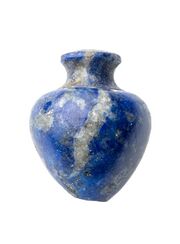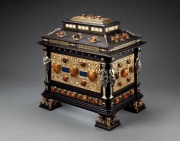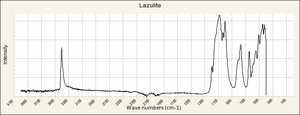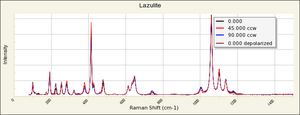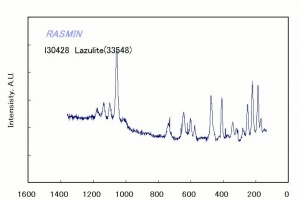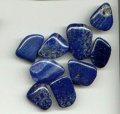Difference between revisions of "Lapis lazuli"
| (One intermediate revision by the same user not shown) | |||
| Line 1: | Line 1: | ||
[[File:27.647-20-13.jpg|thumb|Cylinder seal<br> MFA# 27.647]] | [[File:27.647-20-13.jpg|thumb|Cylinder seal<br> MFA# 27.647]] | ||
| + | [[File:SC310304 (1).jpg|thumb|Earring pendant<br>MFA# 01.8170]] | ||
== Description == | == Description == | ||
[[File:02.86-SC39657.jpg|thumb|German casket<br> MFA# 02.86]] | [[File:02.86-SC39657.jpg|thumb|German casket<br> MFA# 02.86]] | ||
| Line 7: | Line 8: | ||
lazurite; lapis; Persian blue; Fra Angelico Blue; Armenian stone; blue stone; ultramarine blue (pigment); Lapislazuli, Ultramarin (Deut.); lapislázuli (Esp.); lapis lázuli (Esp.); lapis-lazuli (Fr.); lazuryt (Pol.); lápis-lazuli (Port.); lapis lazuli (Ned.); | lazurite; lapis; Persian blue; Fra Angelico Blue; Armenian stone; blue stone; ultramarine blue (pigment); Lapislazuli, Ultramarin (Deut.); lapislázuli (Esp.); lapis lázuli (Esp.); lapis-lazuli (Fr.); lazuryt (Pol.); lápis-lazuli (Port.); lapis lazuli (Ned.); | ||
| − | [[[SliderGallery rightalign|lazuliteRS.jpg~Raman]]] | + | [[[SliderGallery rightalign|Lazulite IR-ATR RRUFF R050110.png~IR-ATR (RRUFF)|Lazulite Raman RRUFF R050110.png~Raman (RRUFF)|lazuliteRS.jpg~Raman (RASMIN)]]] |
| − | |||
== Risks == | == Risks == | ||
| Line 17: | Line 17: | ||
* Decomposed by hydrochloric acid with the precipitation of silica, evolution of hydrogen sulfide (rotten egg smell), and effervescence from calcite inclusions. | * Decomposed by hydrochloric acid with the precipitation of silica, evolution of hydrogen sulfide (rotten egg smell), and effervescence from calcite inclusions. | ||
| − | * Isometric with compact masses | + | * Isometric with compact masses |
| − | * Poor cleavage | + | * Poor cleavage |
| − | * Fracture = uneven | + | * Fracture = uneven |
| − | * Luster = dull to greasy | + | * Luster = dull to greasy |
| − | * Streak = pale blue | + | * Streak = pale blue |
| − | * Dyes may often be detected with an acetone swab | + | * Dyes may often be detected with an acetone swab |
| + | * Fluorescence = weak to moderate green in SW; calcite inclusions may fluoresce pink in LW | ||
{| class="wikitable" | {| class="wikitable" | ||
| Line 36: | Line 37: | ||
|- | |- | ||
! scope="row"| Refractive Index | ! scope="row"| Refractive Index | ||
| − | | 1.50-1.67 | + | | 1.50-1.67 (readings can be difficult) |
|} | |} | ||
Latest revision as of 13:37, 19 December 2022
Description
A brilliant azure-blue color gemstone. Lapis lazuli is a mixture of minerals, primarily containing the Lazurite (blue) with small amounts of Calcite, Sodalite, and gold-color flecks of Pyrite. Lazurite is a sodium, calcium, aluminum sulfo-chlorosilicate. Lapis lazuli has been commercially mined since 3100 BCE at the Badakhshan mines in Afghanistan. Other mines are found in Argentina, Siberia (Lake Baikal), Chile, Myanmar (formerly Burma), Pakistan, and the U.S. (California). The semiprecious blue stone was, and still is, used for jewelry, mosaics and small carvings. Lapis lazuli was also ground and purified to make natural ultramarine blue pigments. Many current pieces of lapis on the market have been dyed or waxed to improve their appearance.
Synonyms and Related Terms
lazurite; lapis; Persian blue; Fra Angelico Blue; Armenian stone; blue stone; ultramarine blue (pigment); Lapislazuli, Ultramarin (Deut.); lapislázuli (Esp.); lapis lázuli (Esp.); lapis-lazuli (Fr.); lazuryt (Pol.); lápis-lazuli (Port.); lapis lazuli (Ned.);
Risks
- Ingestion may result in poisoning if stomach acid is high.
- Inhalation and contact may irritate tissue.
Physical and Chemical Properties
- Decomposed by hydrochloric acid with the precipitation of silica, evolution of hydrogen sulfide (rotten egg smell), and effervescence from calcite inclusions.
- Isometric with compact masses
- Poor cleavage
- Fracture = uneven
- Luster = dull to greasy
- Streak = pale blue
- Dyes may often be detected with an acetone swab
- Fluorescence = weak to moderate green in SW; calcite inclusions may fluoresce pink in LW
| Composition | (Na,Ca)4(Al,SiO4)3(SO4,S,Cl) |
|---|---|
| Mohs Hardness | 5.0 - 5.5 |
| Density | 2.7-2.9 g/ml |
| Refractive Index | 1.50-1.67 (readings can be difficult) |
Comparisons
Properties of Common Gemstones
Characteristics of Common Blue Pigments
Additional Images
Resources and Citations
- Mineralogy Database: Lazurite
- Jack Odgen, Jewellery of the Ancient World, Rizzoli International Publications Inc., New York City, 1982
- Encyclopedia of Archaeology, Glyn E. Daniel, ed., Thomas Y. Crowell Co., New York, 1977
- R.F.Symmes, T.T.Harding, Paul Taylor, Rocks, Fossils and Gems, DK Publishing, Inc., New York City, 1997
- C.W.Chesterman, K.E.Lowe, Audubon Society Field Guide to North American Rocks and Minerals, Alfred A. Knopf, New York, 1979
- Wikipedia: http://en.wikipedia.org/wiki/Lapis_lazuli (Accessed Nov. 9, 2005)
- Yasukazu Suwa, Gemstones: Quality and Value, Volume 1, Sekai Bunka Publishing Inc., Tokyo, 1999 Comment: RI=1.50-1.67; Specific gravity=2.75
- Michael O'Donoghue and Louise Joyner, Identification of Gemstones, Butterworth-Heinemann, Oxford, 2003 Comment: RI=1.50; Specific gravity=2.7-2.9
- G.S.Brady, Materials Handbook, McGraw-Hill Book Co., New York, 1971 Comment: p. 611
- Ralph Mayer, A Dictionary of Art Terms and Techniques, Harper and Row Publishers, New York, 1969 (also 1945 printing)
- Van Nostrand's Scientific Encyclopedia, Douglas M. Considine (ed.), Van Nostrand Reinhold, New York, 1976
- Matt Roberts, Don Etherington, Bookbinding and the Conservation of Books: a Dictionary of Descriptive Terminology, U.S. Government Printing Office, Washington DC, 1982
- Michael McCann, Artist Beware, Watson-Guptill Publications, New York City, 1979

